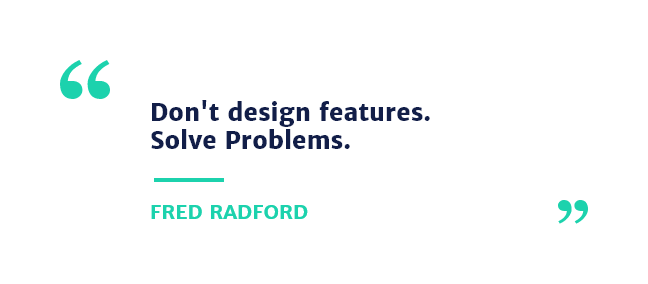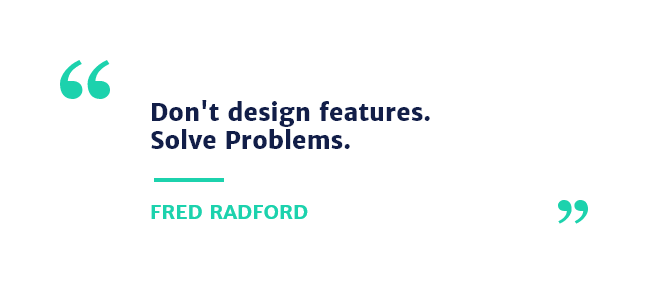Updated: January 24, 2024- 7 min read
This week our #AskMeAnything session welcomed Fred Radford, Product Manager at 8×8, to give you some insights on solving Product Management problems!!
Meet Fred Radford
Fred Radford is the Director / VP of Product Management at 8×8 where he is focused on software, Saas, Mobile, and API solutions. He is an experienced product leader who leads with a lean Product Management methodology encompassing comprehensive hypotheses, efficient validation, correctly scoped MVP, actual customer tests, synthesis of feedback, and observations resulting in iterations that converge upon product-market fit.

Fred has also been a Product Management Instructor at Product School for over 4 years! Some of his specialties include Product Management & Strategy, User Experience, New Product Development, P&L, Entrepreneurship, SaaS, Mobile, Games/Gamification, APIs/SDKs, Lean & Agile (Jira / Pivotal Tracker).
How to Solve Problems
Have you ever said ‘No’ to stakeholders or clients, and if so, how do you communicate this message? What are your reasons for saying ‘No’?
Yes, you have to say no… But you MUST empathize with all stakeholders.
One technique is to not say “no” but say “it is going to cost you.” Make the trade-off impossibly high and see where it goes. For example, “if you want this one feature for this one customer, all other customers will not get an update this year.”
When saying “no,” you might know intuitively that it is a “no,” but you still need to take the time to see it from their perspective and educate and empathize with their situation.
For example, if you have a sales engineer that keeps coming to you with one-off features, just don’t say “we’ll put it in the backlog” (another way to say “no”!), but help them work with the customer to dive into the real problem, if any and what value it will have. If that SE starts asking them-self, “does this move the needle?” then you’ll start getting better quality requests from them.
How do you handle vendor management when they miss deadlines and are not following the same agile timeline as you?
There are a couple of techniques that work well in many Product Management situations. First, take a step back and approach this problem as you would a customer problem. Who are the personas? What is the real problem? What value do you need to have?
It sounds like the problem you’re facing is a symptom of a communication problem, so let’s tackle it from that standpoint.
A tool/framework to use is to understand that ALL estimates are low. They forget about documentation, QA, testing, other work, and meetings, etc. Multiply every engineering estimate by 4 – yes 400% to get a realistic, quality answer. This shouldn’t be done at the high-level (project level) but on the per-story level.
What is the role of PM in managing or defining security features? Is there any resistance from the engineering team?
Don’t design features. Solve problems. What are the security problems that your personas have or could have and what value could you provide to them by solving them?

What is your advice on improving UX focus on products? A dedicated UX team with graphic designers or something else?
Design is no longer “graphics design” but includes everything from information architecture to running focus groups.
I like to have designers that are capable of performing the old “business analyst” role so that I can focus on the epics and acceptance criteria and have the solutions be a joint effort with design leading them. This makes the product much more customer-focused than just trying to drive that focus down the throats of design and engineering from product.
As the Director of Product Management, what are the best approaches you deploy in creating a unified product culture among different component product teams?
Creating a culture is hard. Look at the movie The Internship. Many of the cultural activities are odd, and you wouldn’t see the leadership participating. My best advice is to lead by example and clearly communicate what your expectations are.
What resources do you recommend to help analyze and understand the business models of companies?
First, put yourself in their shoes (as a Product Manager) and ask yourself all the product questions about all their products. Then start doing some eternal research.
Find sites that have information, even if indirect, about the company where you can use their info to lead to more research. For example:
The SEC has lots of public company info.
For start-ups, CrunchBase
is great.
Look into their competitors with something like Owler.
Would you say elements of the Design Thinking process characterizes the bulk of what you do?
Product Managers have to do everything that isn’t getting done to provide value to customers.
That being said, if you are focusing just on design, then you might not be seeing the big picture. The best Product Managers are all about understanding the customer as their priority–which leads to an infinite number of other tasks.

Breaking Into Product Management
What do you look for in a Product Management resume or candidate?
Communication skills
Customer focus – ability to look for problemsç
Ability to answer any question – create custom frameworks
Time management skills
Results – know what is worth solving
Design critic capabilities
Engineering review capabilities
Business acumen outside of the product lifecycle
Willingness and ability to LEARN
What makes a portfolio or cover letter stand out to you?
Focus.
Just like an MVP, there should be a focus on including just what is needed to prove the hypothesis and nothing more.
What were some of your biggest challenges when you first got into Product Management?
The biggest challenges I find in Product Management are focusing on the customer and problem instead of the product and negotiating compromises.
How do you make product trade-offs, and for someone trying to break into Product Management, what are the key concepts to understand to make better tradeoffs?
Whenever I hear “trade-off” or prioritization, I immediately think of creating a custom framework to evaluate the situation so it can be communicated effectively.
Take the problem on as a product and solve it the same way. The key concept is that tradeoffs are one of the “it depends” type answers for products and need to be evaluated as the company grows and changes.

What advice do you have for transferring from enterprise systems to SaaS, software, and API?
The best advice for moving between jobs is to try to change only ONE thing at a time. Change just your company, or just from Entertainment to Saas, etc.
The more changes you make, the more the hiring manager has to have “faith” in your ability to do it instead of proof, and you’ll be going up against those who HAVE done it.
What’s a career you’d love to be doing if you weren’t in product?
Starship Captain!
Let me know if you see any job postings 😉
I am a Senior Product Manager / Director with 18+ years of experience. Is there a Product School in NYC for online or in-person courses you would recommend?
Yes! Product School has an NYC location, and online is also available. First, ask yourself what your goal is. If you have 18 years of experience and are already an expert in design, engineering, and business, then what do you need next?
Do you have any advice for aspiring Product Managers?
Yes, NEVER stop learning!
Create a framework for everything.
Approach everything in life as a product.
Updated: January 24, 2024




